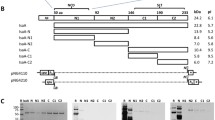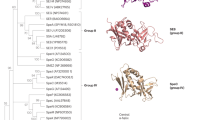Abstract
The staphylococcal enterotoxins have been termed superantigens based on their ability to stimulate polyclonal proliferative responses of murine and human T lymphocytes expressing particular T-cell receptor Vβ gene products. Certain of these toxins have been shown both to activate and to induce anergy in reactive T cells. Staphylococcal enterotoxin B is known to interact with murine T cells bearing Vβ3, −7, −8.1, −8.2, −8.3, and −17. In BALB/c mice Vβ3+ and Vβ17+ T cells are deleted; Vβ7+ T cells are low in frequency. BALB/c mice sensitized to ovalbumin via the skin and airways develop immediate hypersensitivity including IgE/IgGl antiovalbumin antibodies, immediate cutaneous reactivity to ovalbumin and, increased airway responsiveness. In bothin vitro andin vivo studies, the development of these responses has been associated with the Vβ8+ subset of T cells and controlled by Vβ2+ T cells. In view of the central role of Vβ8+ T cells in these responses, we tested the effects of staphylococcal enterotoxin B on the development of immediate hypersensitivity in this system. Intradermal injection of staphylococcal enterotoxin B prevented the development of these responses in the absence of a major deletion of Vβ8+ T cells. The data suggest that the administration of staphylococcal enterotoxin B prevented the antigen-induced expansion of Vβ8+ T cells resulting in a state of unresponsiveness or anergy, thus preventing the manifestations of immediate hypersensitivity. Bacterial toxins may provide a novel approach to intervention in allergic or autoimmune diseases.
Similar content being viewed by others
References
Peavy DL, Adler WH, Smith RT: The mitogenic effects of endotoxin and staphylococcal enterotoxin B on mouse spleen cells and human peripheral lymphocytes. J Immunol 105:1453–1458, 1970
Langford MP, Stanton GJ, Johnson HM: Biological effects of staphylococcal enterotoxin A on human peripheral lymphocytes. Infect Immun 22:62–68, 1978
Calvano SE, Quimby FW, Antonacci AC, Reiser RF, Bergdoll MS, Dineen P: Analysis of the mitogenic effects of toxic shock toxin on human peripheral blood mononuclear cellsin vitro. Clin Immunol Immunopathol 32:99–110, 1984
Fast DJ, Schlievert PM, Nelson RD: Toxic shock syndrome-associated staphylococcal and streptococcal pyrogenic toxins are potent inducers of tumor necrosis factor production. Infect Immun 57:291–294, 1989
Janeway CA, Yagi J, Conrad PJ, Katz ME, Jones B, Vroegop S, and Buxser S: T-cell responses to MIs and to bacterial proteins that mimic its behavior. Immunol Rev 107:61–58, 1989
White J, Herman A, Pullen AM, Kubo R, Kappler JW, Marrack P: The Vβ-specific superantigen staphylococcal enterotoxin B: Stimulation of mature T cells and clonal deletion in neonatal mice. Cell 56:27–35, 1989
Cole BC, Kartchner DR, Welles DJ: Stimulation of mouse lymphocytes by a mitogen derived from mycoplasma arthritis (MAM) VIII. Selective activation of T cells expressing distinct Vβ T cell receptors from various strains of mice by the “superantigen” MAM. J Immunol 142:4131–4137, 1989
Callahan J, Herman A, Kappler JW, Marrack P: Stimulation of DIO.BR T cells with superantigenic staphylococcal toxins. J Immunol 144:2473–2479, 1990
Marrack P, Kappler J: The staphylococcal enterotoxins and their relatives. Science 24:705–711, 1990
Rellahan BL, Jone LA, Kruisbeek AM, Fry AM, Matis LA:In vivo induction of anergy in peripheral Vβ8+ T cells by staphylococcal enterotoxin B. J Exp Med 172:1091–1100, 1990
Kawabe Y, Ochi A: Programmed cell death and extrathymic reduction of Vβ8+ CD4+ T cells in staphylococcal enterotoxin B specific tolerance. Nature 349:245–248, 1991
MacDonald HR, Baschieri S, Lees RK: Clonal expansion precedes anergy and death of Vβ8+ peripheral T cells responding to staphylococcal enterotoxin Bin vivo. Eur J Immunol 21:1963–1966, 1991
Vercelli DH, Jabara H, Arai K, Geha RS: Induction of human IgE synthesis requires interleukin 4 and T/B cell interactions involving the T cell receptor/CD3 complex and MHC class II antigens. J Exp Med 169:1295–1307, 1989
Lebman DA, Coffman RL: Interleukin 4 causes isotype switching to IgE in T cell stimulated clonal B cell cultures. J Exp Med 168:853–862, 1988
Vercelli D, Geha RS: Regulation of IgE synthesis in humans. J Clin Invest 9:75–85, 1989
Finkelman FD, Katona IM, Urban JF Jr, Holmes J, Ohara J, Tung AS, Sample JVG, Paul WE: IL-4 is required to generate and sustainin vivo IgE responses. J Immunol 141:2335–2341, 1988
Finkelman FD, Katona I, Urban JF Jr, Snapper CM, Ohara J, Paul WE: Suppression ofin vivo polyclonal IgE responses by monoclonal antibody to the lymphokine BSF-1. Proc Natl Acad Sci USA 83:9675–9678, 1986
Finkelman FD, Urban JF Jr, Beckmann MP, Schooley KA, Holmes JM, Katona IM: Regulation of murinein vivo IgG and IgE responses by a monoclonal anti-IL-4 receptor antibody. Int Immunol 3:599–605, 1991
Beckmann MP, Schooley KA, Gallis B, Bander Bos T, Friend D, Alpert AR, Raunio R, Prickett KS, Baker PE, Park LS: Monoclonal antibodies block murine IL-4 receptor function. J Immunol 144: 4212–4217, 1990
Sato TA, Widmer MB, Finkelman FD, Madani H, Jacobs CA, Grabstein KH, Maliszewski CR: Recombinant soluble murine IL-4 receptor can inhibit or enhance IgE responsesin vivo. J Immunol 150:2717–2723, 1993
Coffman RL, Carty J: A T cell activity that enhances IgE production and its inhibition by interferon-γ. J Immunol 136:949–954, 1986
Pene J, Rousset F, Briere F, Chretien L, Bonnefoy JY, Spits H, Yokata T, Arai N, Arai KI, Banchereau J, DeVries JE: IgE production by normal human lymphocytes is induced by interleukin 4 and suppressed by interferonsα, ψ and prostaglandin E2. Proc Natl Acad Sci USA 85:6880–6884, 1988
Gauchat JF, Lebman DA, Coffman RL, Gascan H, DeVries J: Structure and expression of germline E transcripts induced by interleukin 4 to switch to IgE production. J Exp Med 172:463–473, 1990
Lack G, Renz H, Saloga J, Bradley KL, Loader J, Leung DYM, Larsen G, Gelfand EW: Nebulized but not parenteral interferon-γ decreases IgE production and normalizes airways function in a murine model of allergen sensitization. J Immunol 152:2545–2546, 1994
Renz R, Smith HR, Henson JE, Ray BS, Irvin CG, Gelfand EW: Aerosolized antigen exposure without adjuvant causes increased IgE production and increased airway responsiveness in the mouse. J Allergy Clin Immunol 89:1127–1138, 1992
Larsen GL, Renz H, Loader JE, Bradley KL, Gelfand EW: Airway response to electrical field stimulation in sensitized inbred mice: Passive transfer of increased responsiveness with peribronchial lymph nodes. J Clin Invest 89:747–752, 1992
Saloga J, Renz H, Lack G, Bradley K, Larsen G, Gelfand EW: Development and transfer of immediate cutaneous hypersensitivity in mice exposed to aerosolized antigen. J Clin Invest 91:133–140, 1993
Renz H, Bradley KL, Marrack P, Gelfand EW: T cells expressing variable elements of T-cell receptorβ8 andβ2 chain regulate murine IgE production. Proc Natl Acad Sci USA 89:6438–6442, 1992
Renz H, Bradley K, Saloga L, Loader J, Larsen GL, Gelfand EW: T cells expressing specific Vβ elements regulate IgE production and airways responsivenessin vivo. J Exp Med 177:1175–1180, 1993
Saloga J, Renz H, Larsen GL, Gelfand EW: Increased airways responsiveness depends on local challenge with antigen. Am J Resp Crit Care Med 149:65–70, 1994
O'Hehir RE, Lamb JR: Induction of specific clonal anergy in human T lymphocytes byStaphylococcus aureus enterotoxins. Proc Natl Acad Sci USA 87:8884–8888, 1990
O'Hehir RE, Aguilar BA, Schmidt TJ, Gollnick SO, Lamb JR: Functional inactivation of dermatophagoides spp. (house dust mite) reactive human T-cell clones. Clin Exp Allergy 21:209–215, 1991
Rott O, Wekerle H, Fleischer B: Protection from experimental allergic encephalomyelitis by application of a bacterial superantigen. Int Immunol 4:347–353, 1992
Author information
Authors and Affiliations
Rights and permissions
About this article
Cite this article
Gelfand, E.W., Saloga, J. & Lack, G. Modification of immediate hypersensitivity responses by staphyloccocal enterotoxin B. J Clin Immunol 15 (Suppl 6), S37–S41 (1995). https://doi.org/10.1007/BF01540892
Issue Date:
DOI: https://doi.org/10.1007/BF01540892




